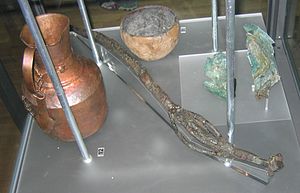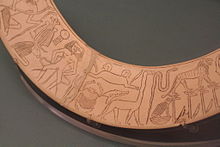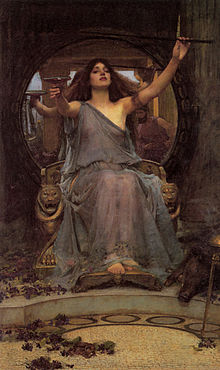- Wand
-
For other uses, see Wand (disambiguation).
 An 82 cm long wand of iron with bronze details and a unique model of a house on the top. It was discovered in a Völva's grave in Köpingsvik, Öland. There is also a pitcher from Persia or Central Asia, and a West European bronze bowl. Dressed in a bear pelt, she had received a ship burial with both human and animal sacrifice. The finds are on display in the Swedish Museum of National Antiquities in Stockholm.
An 82 cm long wand of iron with bronze details and a unique model of a house on the top. It was discovered in a Völva's grave in Köpingsvik, Öland. There is also a pitcher from Persia or Central Asia, and a West European bronze bowl. Dressed in a bear pelt, she had received a ship burial with both human and animal sacrifice. The finds are on display in the Swedish Museum of National Antiquities in Stockholm.
A wand is a thin, straight, hand-held stick of wood, stone, ivory, or metal. Generally, in modern language, wands are ceremonial and/or have associations with magic but there have been other uses, all stemming from the original meaning as a synonym of rod and virge, both of which had a similar development.
Contents
Symbolism
In ecclesiastical and formal government ceremonial, special officials may carry a wand of office or staff of office representing their power. Compare in this context the function of the ceremonial mace, the sceptre, and the staff of office. Its age may be even greater, as Stone Age cave paintings show figures holding sticks, which may be symbolic representations of their power.[1] Then again, maybe these were just the instruments required to write those hieroglyphs on the walls.
Mystical, occult, and religious usage
 Ancient Egyptian wand. From the collection of the Brooklyn Museum.
Ancient Egyptian wand. From the collection of the Brooklyn Museum.
In Pharaonic Egypt, toilette articles, weapons against possible enemies, amulets against serpents, were also left in the tomb, together with magic texts and a magic wand which enabled the ba (soul) to use them.
In classical Greco-Roman mythology, the god Hermes/Mercury has a special wand called a caduceus.
Six- to eight-foot-long staves with metal tips adorning them are carried traditionally in Freemasonry during rituals of the Craft. Ceremonial uses may have several wands for different purposes, such as the Fire Wand and the Lotus Wand in the Hermetic Order of the Golden Dawn. In Zoroastrianism, there is a similar ritual implement called a barsom. In Wicca and Ceremonial magic, practitioners use several magical tools including wands for the channeling of energy—they serve a similar purpose to the athame although the two have their distinct uses. While an athame is generally used to command, a wand is seen as more gentle and is used to invite or encourage. Though traditionally made of wood, they can also consist of metal or crystal. Practitioners usually prune a branch from an Oak, Hazel, or other tree, or may even buy wood from a hardware store, and then carve it and add decorations to personalize it; however, one can also purchase ready-made wands. In Wicca the wand usually represents the element air, or sometimes fire, although contemporary wand makers also create wands for the elements of earth and water as well. The wand is most often used by modern Pagans, witches, Shamans and others in rituals, healing and spell casting.
There is some scholarly opinion that the magic wand may have its roots as a symbol of the phallus. It may also have originated as the drumming stick of a shaman, especially in Central Asia and Siberia, as when using it to bang on his drum or point, to perform religious, healing, and magical ceremonies.[2]
Tarot cards
"Wands" is also another name for the suit of Batons or Rods, a suit of the minor arcana of the Tarot. It is normally associated with the element of fire, again as a symbol of the phallus.
Other uses
- In music, the term sometimes applies to the modern model of conductor's baton (the earlier staff and baton cantoral being heavier and thus unfit for precise gestures).
- In literary language, "wand" can be a synonym for rod as an implement for corporal punishment, in the generic sense: either a multiple rod or a single branch (switch or cane), but not a specific physical type.
- Given their various symbolic and other associations, wands are suitable pervertibles, especially for role play.
- Based on their magical symbolism, stage magicians often use "magic wands" as part of their misdirection. These wands are traditionally black, with white tips.
- A lacrosse stick is colloquially referred to as a "wand."
- "To wand" is a colloquial verb that means to check something with a handheld metal detector, such as at the airport and high security buildings.[3]
- Wooden wands of about 60" in length were popular exercise implements during the Victorian era, particularly in the U.S.A. and in Canada, being used to perform various flexibility and strengthening routines.
- Wand is also a common reference to a Automotive handbrake/parking brake, in motorsport rally drivers would refer to their hydraulic handbrakes as "the Wand"
Modern popular culture
The first magical wand featured in the Odyssey: that of Circe, who used it to transform Odysseus's men into animals. Italian fairy tales put them into the hands of the powerful fairies by the late Middle Ages.[4]In the ballads such as Allison Gross and The Laily Worm and the Machrel of the Sea, the villainesses use silver wands to transform their victims.[5] In The Chronicles of Narnia: The Lion, the Witch and the Wardrobe, the White Witch's most feared tool is her wand, whose magic is capable of turning people into stone.
Magic wands commonly feature in works of fantasy fiction as spell-casting tools. Few other common denominators exist, so the capabilities of wands vary wildly. Note that wands fill basically the same role as wizards' staffs, though staffs generally convey a more 'serious' image; a fairy godmother would often use a wand, possibly with a star or some form of decoration on the end, while Gandalf would most likely not (however, in The Hobbit, he is said to use a wand, referring to his staff, to fight the goblins of the Misty Mountains and their Wargs). Gandalf's name is Northern Mannish (one of Tolkien's invented languages, similar to North Germanic languages) for "Elf of the Wand", a reference to the staff he carries. In dramatic fiction, wands can serve as weapons in magical duels. Wands are also common in the fictional fantasy world of J. K. Rowling's Harry Potter series, where one, the Elder Wand, serves as a plot device in the last book. Wands in Harry Potter also are very special, as a wand must choose a person. A wand is also present in the Children of the Red King series in the possession of Charlie Bone as well as the popular MMORPG World of Warcraft where caster classes such as the mage and warlock use wands offensively.
See also
- Ceremonial magic
- Rhabdomancy
- Sex magic
- White Wand
- Harry Potter
References
- ^ David Colbert, The Magical Worlds of Harry Potter, p 195, ISBN 0-9708442-0-4
- ^ Ivar Lissner, Man, God and Magic, New York, Putnam, 1961
- ^ They Wanded My Bare Feet
- ^ "Raffaella Benvenuto". Italian Fairies: Fate, Folletti, and Other Creatures of Legend. http://www.endicott-studio.com/rdrm/rrItalianF.html.
- ^ Francis James Child, The English and Scottish Popular Ballads, v 1, p 315-6, Dover Publications, New York 1965
 This article incorporates text from a publication now in the public domain: Herbermann, Charles, ed (1913). Catholic Encyclopedia. Robert Appleton Company.Categories:
This article incorporates text from a publication now in the public domain: Herbermann, Charles, ed (1913). Catholic Encyclopedia. Robert Appleton Company.Categories:- Ceremonial weapons
- Formal insignia
- Magic (paranormal)
Wikimedia Foundation. 2010.


